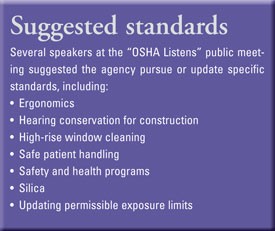OSHA listens
Agency holds daylong public meeting
By Kyle W. Morrison, associate editorIn an unprecedented event, OSHA hosted a daylong public meeting in March to solicit advice from stakeholders on a variety of ways the 40-year-old agency could address key issues.
“OSHA Listens” consisted of 45 panelists who appeared before high-ranking OSHA officials – including administrator David Michaels – to discuss issues such as how to improve worker safety, which standards should be promulgated or updated, and how to make the agency more effective. Dozens of others who were not in attendance at the forum submitted written testimony. “Your ideas may help us save lives,” Michaels said in his opening remarks. In addition to Michaels, OSHA Director of Enforcement Richard Fairfax (now assistant OSHA administrator), Director of Standards and Guidance Dorothy Dougherty and Chief of Staff Deborah Berkowitz attended the hearing.
Families
The first panel featured family members of workers killed on the job. Katherine Rodriguez, whose father was killed in a 2004 refinery explosion along with two other workers, described how she learned that OSHA had levied fines against the company not from the agency but from the media.
“I anxiously read the article and thought, ‘Why am I reading this in the newspaper?’” she said. “Did the local [OSHA] office not feel like the families of these three men would want to know the outcome?” Celeste Monforton, who chairs the Occupational Health and Safety Section of the Washington-based American Public Health Association, spoke on behalf of United Support and Memorial for Workplace Fatalities, a Lexington, KY-based organization for family members who have lost loved ones in on-the-job incidents. Monforton urged the Obama administration to support the Protecting America’s Workers Act for its provisions that would offer new rights to injured workers and their families, and suggested OSHA allow family members to partake in follow-up inspections after receiving appropriate training. “No one is more determined than a family member to ensure that dangerous conditions and practices are eliminated once and for all,” she said.
Assistance versus enforcement
Several panelists touched on the often-contentious debate of compliance assistance versus OSHA enforcement. While no one came out in opposition to either tactic in and of itself, stakeholders did voice their preferences.
“Aggressive enforcement tactics simply coupled with higher penalties and public shaming will not foster the needed trust that employers must have for the agency to be successful,” the Washington-based National Association of Manufacturers’ Keith Smith said. Marc Freedman of the U.S. Chamber of Commerce stressed that enforcement is not a proactive strategy, and said the recent trend of decreasing injury, illness and fatality rates shows compliance assistance is key to continuing the decline.

In contrast, OSHA’s recent more aggressive stance won praise from Matt Shudtz, policy analyst with the Washington-based Center for Progressive Reform, who suggested the agency scale back compliance assistance funding spent on large employers. The AFL-CIO’s Peg Seminario emphasized the need for a strategic and effective enforcement strategy to ensure OSHA regulations are followed. “You are the only one that sets standards, and you are the only ones who enforce,” she reminded OSHA officials. “If you don’t do that, no one else does.”
VPP
Many stakeholders encouraged OSHA to continue to support the Voluntary Protection Programs, which recently have faced potential budget cuts from OSHA and transfer of staff to enforcement duties.
“By significantly reducing the VPP budget and shifting staff members to enforcement efforts, OSHA is turning its back on key allies in a battle to promote a culture of safety in the American workplace,” said Stephen Sandherr, CEO of the Associated General Contractors of America in Arlington, VA.
A few speakers suggested using the status of VPP worksites, which by nature of being in the program go above and beyond OSHA requirements, to further push those sites for greater excellence. Peter Dooley of the Western New York Council on Occupational Safety and Health said OSHA should require VPP sites to implement a comprehensive ergonomics program, and ORC Worldwide’s Frank White suggested VPP sites should not be exempt from Special Emphasis Programs.
Injury and illness rates
A major topic at the hearing was injury and illness recordkeeping – the data OSHA uses to target its resources and gauge its effectiveness. Kathleen McPhaul, chair of the American Public Health Association, said the data was “vital” for public health efforts, and called on OSHA to count and track all work-related injuries and illnesses, accompanied by audits of employers’ records.
Unite Here! International’s Pamela Vossenas questioned the quality of the data being kept by employers and suggested various “disincentive” programs – such as Safety Bingo or raffles – may not be in compliance with OSHA’s recordkeeping standard. Noting that injury, illness and fatality rates have their limitations, Michaels asked several panelists what metrics OSHA should be using to measure the success of employers, and what metrics should be used to target inspections. Among the suggestions from various panelists were using near-miss data, a focus on health risks through exposure monitoring, surveys and obtaining information from health professionals.
Post a comment to this article
Safety+Health welcomes comments that promote respectful dialogue. Please stay on topic. Comments that contain personal attacks, profanity or abusive language – or those aggressively promoting products or services – will be removed. We reserve the right to determine which comments violate our comment policy. (Anonymous comments are welcome; merely skip the “name” field in the comment box. An email address is required but will not be included with your comment.)

